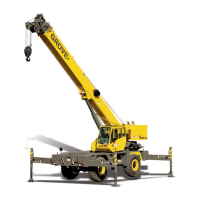Manitowoc Published 07-19-16, Control # 249-01 1-53
2250 SERVICE/MAINTENANCE MANUAL INTRODUCTION
Upper Accessory System Components
General
The upper accessory system components include four
jacking cylinders, front and rear adapter frame pin cylinders,
and gantry raising cylinders. During normal operation the
upper accessory solenoid valves are “motor spooled” where
both cylinder ports and the tank port of the valve spool
section are connected in the center position and open to the
tank.
Setup mode must be selected for operating the accessory
system components. In Setup mode, the programmable
controller (PC) supplies power to the equalizer limit switch,
turns off boom hoist UP/DOWN limits, and prevents travel/
swing from being operated faster than one-third speed.
The auxiliary pump is the hydraulic pressure source to
operate the accessory system components. Hydraulic fluid
from the auxiliary pump flows through the auxiliary system’s
disable-relief valve HS-12. Hydraulic fluid enters the upper
accessory valve and flows through to the lower accessory
valve.
The auxiliary system’s disable-relief valve HS-12 is
controlled by the PC. During normal operation the relief valve
is open and excess supply flow from the auxiliary pump is
dumped through the valve to the tank. When a component of
either accessory system is enabled, an input signal is sent to
the PC. The PC sends a 12 V output signal to the auxiliary
system’s disable-relief valve HS-12 that adjusts system
pressure to 276 bar (4,000 psi).
Hydraulic pilot pressure to shift the upper accessory valves is
from the boom hoist charge pump at 24 bar (350 psi).
Jacking Cylinders
See Figure 1-32 and Figure 1-33 for the following.
Jacking cylinders are mounted on each corner of the rotating
bed. Jacking cylinder operation is controlled with the
switches on the jacking remote control and PC
programming. Operation of all four jacking cylinders is the
same. All cylinders can be operated at the same time if the
crane is level.
With the engine running, power is available to the jacking
remote control when the cable is connected at the auxiliary
valve junction box on the right side of the rotating bed.
Pressing the power button and jacking remote switch(es)
supplies power to operate the jacking cylinders.
The rotating bed level sensor monitors the rotating bed level
when the ALL switch is used. The sensor controls fluid to
each cylinder by opening/closing the control valves.
Each jacking cylinder has a counterbalance valve at the
cylinder ports. Counterbalance valves ensure smooth control
when raising or lowering the crane. Counterbalance valves
lock the jacking cylinders in place if there is a hydraulic line
breakage or accidental operation of the control valve when
the crane's power is shut down. Also, counterbalance valves
provide relief protection for the cylinders and shields them
from mechanical overloading.
When a jacking cylinder control valve is not enabled, it shifts
to the neutral position where both valve section cylinder
ports are connected to the tank. This prevents inline
pressure from opening the counterbalance valve, holding the
rotating bed load in position by the counterbalance valve.
Jacking Cylinders Extend
The following operating description is for front jacks.
Operation of the rear jacks is the same, except different
switches are used.
When the power button is pressed and both left and right
front jack switches are held in the UP (extend) position, an
input voltage is sent through a diode to the PC. The PC
sends a 12 V output signal to the auxiliary system’s disable-
relief valve HS-12 that adjusts system pressure to 276 bar
(4,000 psi).
The PC also sends a 12 V output signal to enable the jacking
solenoids HS-25 and HS-27 to extend the left and right front
jacks. Hydraulic pilot pressure at 24 bar (350 psi) or 21 bar
(300 psi) shifts the valve(s) in the selected direction.
Hydraulic fluid from the auxiliary pump flows through the
auxiliary system’s disable-relief valve HS-12 and enters
accessory valve. Fluid exits valve sections of the accessory
valve and flows through free-flow check valve sections of the
counterbalance valves. Fluid then enters the piston end of
the front jacking cylinders, extending the cylinders to lift the
front of the rotating bed.
Fluid returning to the tank from the rod end of the jacking
cylinders is blocked by free-flow check valve sections of the
counterbalance valves and goes through the flow-restraining
relief valve set at 207 bar (3,000 psi). Counterbalance valves
provide deceleration control with 3:1 pilot ratio of the relief
WARNING
Collapsing Hazard!
Avoid possible injury. Keep the rotating bed as level as
possible while jacking. Operating the jacking cylinder with
the rotating bed more than 3° out of level can cause
structural damage to the jacking cylinders and possible
collapse of the rotating bed.
When the rotating bed is 3° out of level, a red level
warning light and beeper comes ON.

